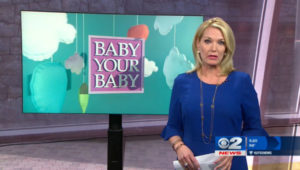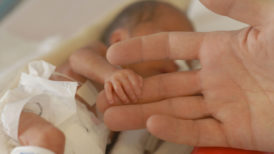August is World Breastfeeding Month, and several local organizations are hoping a new take on breastfeeding will get more moms to try it with their babies. And, the effort seeks to educate dads about breastfeeding to get them more involved in the process.
Research shows that 39-percent of Florida’s children born in 2008 were breastfed for the first six months, with only 20-percent breast fed for a year. That’s less than the two years recommended by the World Health Organization as well as the American Pediatric Association.
And, it’s partly because of stigmas or misconceptions associated with breastfeeding children.
“You hear, your breasts are going to sag, you hear some men don’t really want their or she might have the same view that this is a sexual thing, this is not a feeding mechanism, other ones are you’ve got a child that’s really spoiled, or here you’ve got a child who is a ‘booby-baby,’ who’s up under their mom too much,” remarked Quashier Flood-Strouble, a breastfeeding peer counselor and a certified lactation counselor in Tallahassee.
She says while the breastfeeding trend is starting to improve by educating more women, she feels there is one group of people that is getting lost in the breastfeeding process: men.
So, she and her brother, Mu-Tor Flood, created a movie aimed at helping fathers understand how integral they are to the breastfeeding process.
The locally-made film is called “Dads and Breastfeeding: The Official Guide for New Fathers.” Flood-Strouble says the influence fathers have shouldn’t just come into play when it comes to deciding whether to breastfeed.
For example, she says she had originally planned to have a natural birth with her first son, but due to complications, she later had to undergo a C-Section. Flood-Strouble says she had wanted to get her son breast feeding right away, but she couldn’t speak up because she was so tired from the ordeal and the drugs in her system. And, that’s when her husband Bruce Strouble stepped in:
“And, the nurses were actually trying to give him formula. I knew she wasn’t going to go for that. So, I had to be her mouthpiece basically,” said Strouble. “So, I had to go there and say no, no, no! She’s going to pump. They’re got her on the pump, and I’m running the colostrum [pump] down so that they can feed the baby. That’s just one way you help. Being there, being involved, and help her stay with it by just staying supportive.”
And, now Breastfeeding in the Strouble family is a tradition that’s carried down to their two other sons.
It’s also a practice that Bruce Strouble hopes to spread throughout the community. He and his group, Citizens for Sustainable Future Incorporated, recently held a panel discussion at the Leon County Health Department about the importance of breastfeeding. Included in the effort are the Florida Department of Health’s Office of Minority Health, Whole Child Leon, and the county’s health department.
Dykibra Gaskin is the nutrition educator at the Leon County health department who works with women, children, and infants. She says critics often turn the image of mothers feeding their babies in public into a sexual act because they believe the breast is indecently exposed. She says what fathers can do is to try and de-sexualize the breast by playing a more active role in defending it. Gaskin says in fact, she’s seen dads who do just that.
“They’re really cool about it. They’re like well, this is how she feeds our baby,” said Gaskin. “We have to be really nonchalant about it. This how we feed our baby. Bottles are not an option. So, men can play a role by defending his wife, defending his baby. Speak up! Don’t play a passive role!”
Doctor Esaias Lee, who practices Family Medicine at Capital Health Plan, says dads should also be prepared to help with the discomfort breastfeeding moms sometimes face when the baby’s mouth latches on, and encourage moms not to quit.
“As a dad, through your reading, you learn that you may need to get some dish clothes, maybe get them moist,” said Dr. Lee. “And, begin to help your soulmate, your wife or your significant other prepare her nipple to deal with some of this discomfort. So, it’s almost like you guys are in training camp as a couple. You’re trying to prepare yourself for this upcoming event so that you all can give your baby the best type of nourishment that it can receive.”
And, Dexter Harrell, a believer in breastfeeding, agrees. The 40-year-old man is the father of four children, including a 15-month old daughter, who is still breastfed. He says he and his wife struggled with breastfeeding his two oldest children, but things worked out for the last two. He says he’s glad he was able to help his wife through the process and points out the benefits are clear.
One of the biggest debates relating to the breastfeeding process is breastfeeding versus baby formula. While experts say some mothers find they don’t have to worry about their diet OR have to feed their babies as frequently because baby formula digests slower than breast milk, Harrell says breastfeeding, for him, wins hands down. He says, mostly because, it saved his family money and it’s very convenient.
Harrell says he encourages all fathers to get on board and involved in the breastfeeding process. He adds the movie is also a beneficial tool to help fathers regarding misconceptions or questions they might have about breastfeeding in general. Harrell and his family can also be seen in the “The Dads Official Guide to Breastfeeding” movie. To learn more about the movie, visit www.mqfproductions.com.







